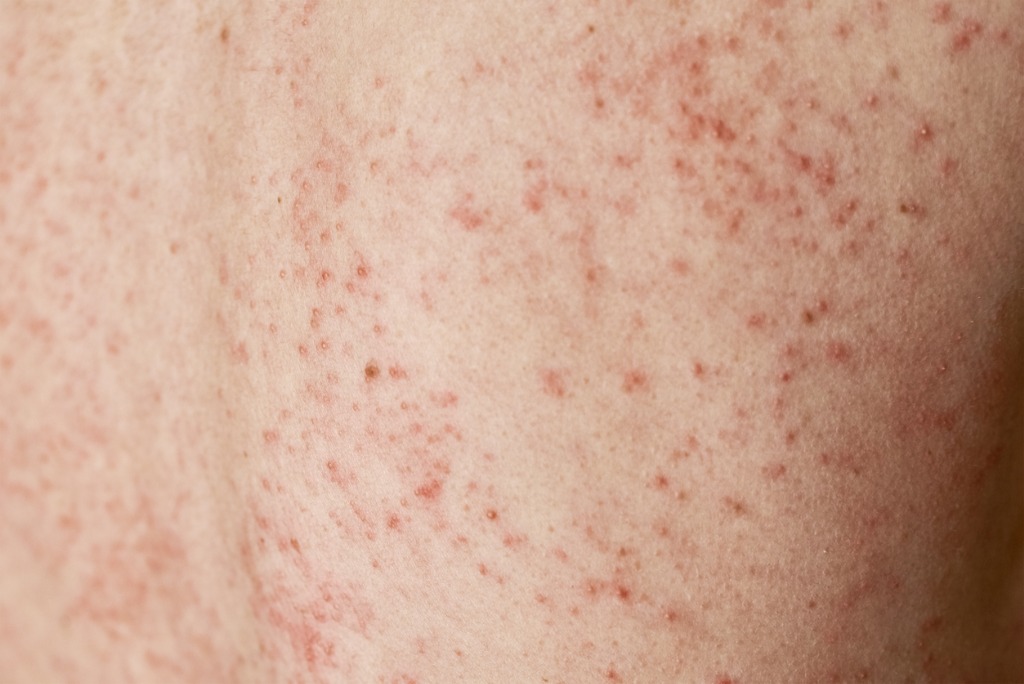Prurigo nodularis is a skin condition characterized by the development of small nodular lesions, which are often severely itchy. People afflicted with this disease may develop a few lesions or potentially over 200, all of which with varying sizes. Often confused with other skin conditions, prurigo nodularis symptoms may resemble eczema or psoriasis, making it challenging to diagnose and treat.
Prurigo Nodularis Symptoms
If you are affected by prurigo nodularis, you may notice the development of small, itchy lesions. These bumps may be:
- Round or oval-shaped
- Hard and elevated above the skin
- Flesh-colored or slightly darker
- Symmetrical in distribution
- Crusty and scaly
At times, the areas of skin affected by this condition may thicken or become hyperkeratotic, a process similar to how the skin forms calluses. The skin may also become dry and leathery, known as the lichenification process, which may appear as symptoms of eczema.
Prurigo nodularis symptoms may occur in episodes of flare-ups and remissions, or they may be chronic. They are typically exacerbated by sweat, heat, clothing, and stress. Often, the scratching is so severe that it can interfere with sleep and psychological well-being. Excessive itching may also cause infections to develop.
What Causes Prurigo Nodularis?
There is no clear cause of prurigo nodularis, but the development of this disease has been associated with the presence of the following conditions:
- Skin diseases: atopic dermatitis, cutaneous T-cell lymphoma, lichen planus
- Systemic diseases: HIV, kidney disease, liver disease, thyroid disease, hyperparathyroidism, diabetes, anemia, celiac disease, certain cancers
- Neurological causes: nerve damage from herpes or shingles infection, polyneuropathies, brachioradial pruritis, notalgia paresthetic
- Bacterial and viral infections: tuberculosis, mucogenicum, herpes zoster, hepatitis C
- Psychiatric causes: psychogenic pruritis, which is an itching sensation associated with depression, anxiety, and dissociative disorders
Risk Factors
Along with these conditions, a few risk factors may place you at a higher risk of developing prurigo nodularis, such as:
- 54.2% of cases are in women, while 45.5% are in men
- Most likely to occur between the ages of 40 and 69
- 3.4 times more common in African Americans
How to Diagnose Prurigo Nodularis
Prurigo nodularis is typically diagnosed by a physical examination with your dermatologist. An accurate diagnosis usually requires a microscopic examination of the lesions to analyze the characteristic appearance of the skin’s bumps. In addition, your doctor may order a biopsy, which is when a small sample of tissue is taken from an affected area and examined under a microscope. A biopsy can help confirm the diagnosis and rule out other conditions with similar symptoms.
Once a diagnosis is confirmed, your provider may order other clinical and microscopy exams, including:
- Complete blood cell count (CBC)
- Comprehensive metabolic panel (CMP)
- Liver and kidney function tests
- Thyroid hormone panel
These tests can help diagnose the presence of systemic diseases that may be contributing to your prurigo nodularis diagnosis.
Treatment Options for Prurigo Nodularis
Although there is no definitive cure for this condition, there are a few different treatment methods targeted at alleviating uncomfortable prurigo nodularis symptoms. Here are some general tips to help improve the quality of life of those living with prurigo nodularis:
- Keep nails short
- Wear protective clothing, such as gloves and long sleeves
- Cover nodules with wraps or bandages
- Use gentle moisturizers
- Try calamine or menthol lotions
- Stay in a cool and comfortable environment
- Limit exposure to stress
- Wear sunscreen when exposed to UV rays
Paired with general care strategies, there are some treatments that may help manage prurigo nodularis symptoms and improve the appearance of the lesions, including:
- Topical treatment: topical and intralesional corticosteroids, calcineurin inhibitors, capsaicin, vitamin D analogs
- Menthol in low concentrations
- Antihistamines
- Phototherapy
- Oral immunosuppressive therapy
Explore New Treatments With Olympian Clinical Research
If you are interested in exploring new treatment options for prurigo nodularis, contact Olympian Clinical Research (OCR). OCR conducts research studies for investigational medications that may reduce the itching associated with this condition. All study-related care and medications are free, and you may be compensated for your time and travel. Fill out an application today to find out if you qualify for this study.

Recent Comments